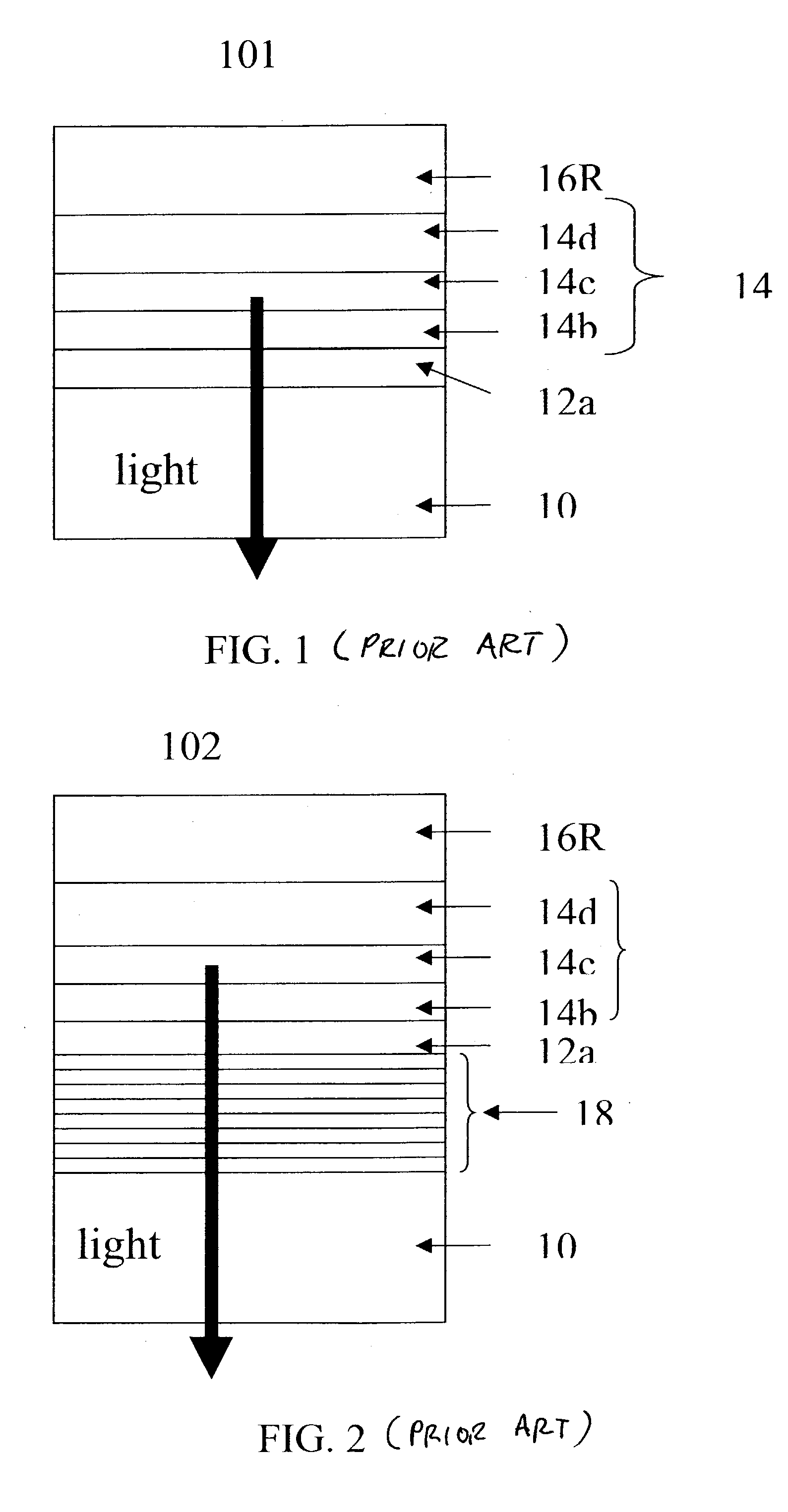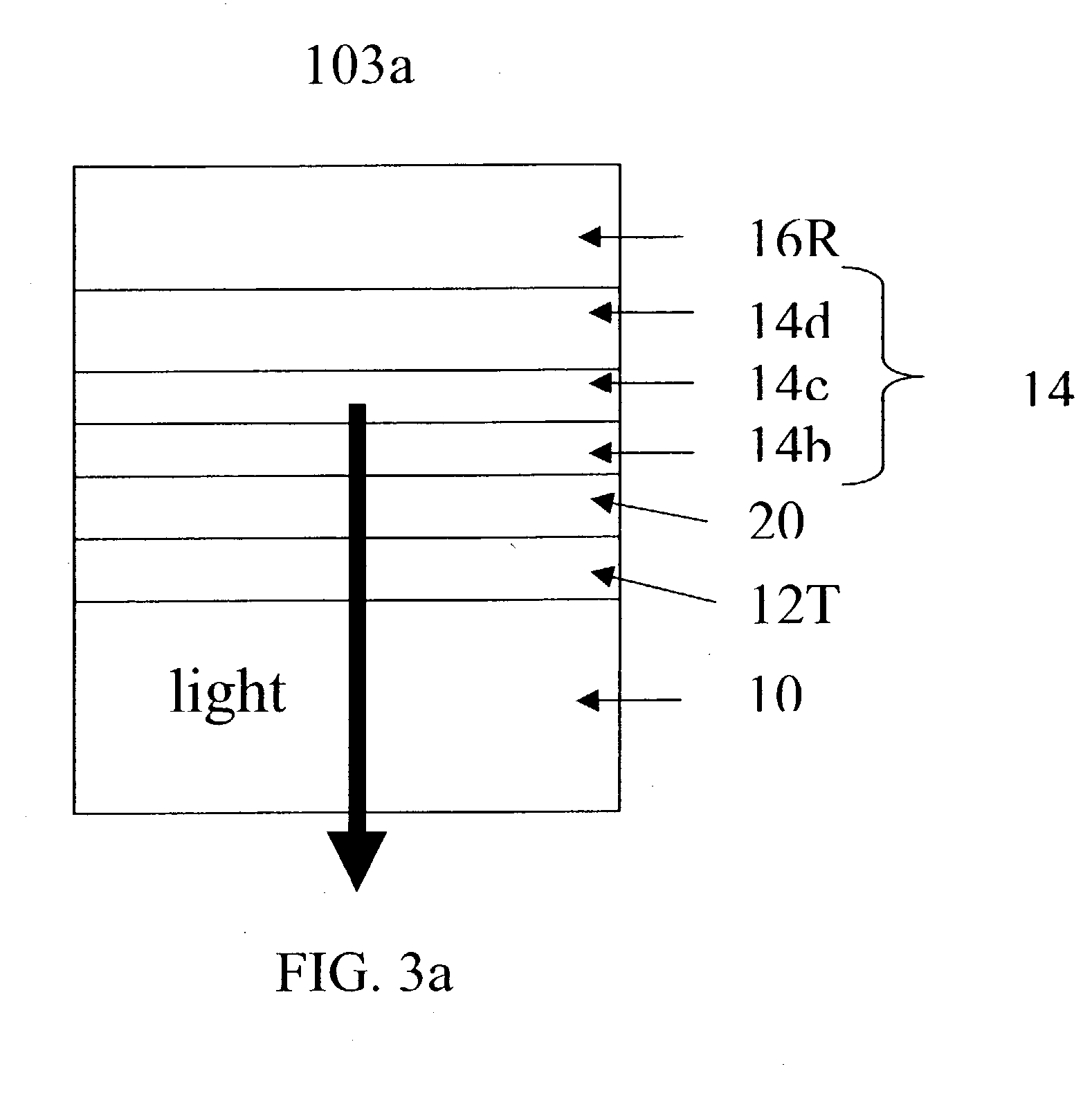Color OLED display with improved emission
a technology of color oled and emission, which is applied in the direction of electroluminescent light sources, thermoelectric devices, foundation engineering, etc., can solve the problems of difficult high-performance fabrication, difficult to fabricate high-performance devices, and difficult to fabricate stable devices. , the total luminance integrated over the visible wavelength range is much less improved, and the effect of reducing over a similar device without the microcavity
- Summary
- Abstract
- Description
- Claims
- Application Information
AI Technical Summary
Problems solved by technology
Method used
Image
Examples
example 1
[0057] Example 1 compares the theoretically predicted luminance output of a bottom emitting microcavity OLED device 103a as shown in FIG. 3a in accordance with the present invention against two comparative devices:
[0058] (a) an OLED device 103b without a microcavity, and
[0059] (b) a microcavity OLED device 103c using a QWS as one of the mirrors for the microcavity.
[0060] OLED device 103b shown in FIG. 3b was similar in construction to microcavity OLED device 103a except that the semitransparent metallic bottom-electrode 12T which is an Ag anode was replaced by an ITO transparent bottom-electrode 12a. This device represents an OLED device without microcavity, although there is always some optical interference effect in a multi-layer device.
[0061] Microcavity OLED device 103c shown in FIG. 3c was similar in construction to OLED device 103b except that a QWS reflecting mirror 18 was disposed between substrate 10 and transparent bottom-electrode 12a. The QWS reflecting mirror 18 was of ...
example 2
[0064] Example 2 is a demonstration of the benefit of the absorption-reduction layer 22 for a bottom emitting device.
[0065] FIG. 3d illustrates schematically the cross-sectional view of a bottom emitting microcavity OLED device 103d. Microcavity OLED device 103d was similar in structure to microcavity OLED device 103a except an absorption-reduction layer 22 was disposed between substrate 10 and semitransparent metallic bottom-electrode 12T. For this example, ITO was selected as the absorption-reduction layer 22. Our calculations showed that the effectiveness of the absorption-reduction layer 22 in enhancing luminance output would improve if a higher index of refraction material was used. As will be apparent from Example 4, luminance output could also be increased if the absorption-reduction layer 22 were in direct contact with air rather than with glass. The thickness of all layers was optimized as in Example 1. The results of the calculation are summarized in Table 2. It can be see...
example 3
[0066] Example 3 compares the theoretically predicted luminance output of a top-emitting microcavity OLED device 104a in accordance with the present invention against two comparative devices:
[0067] (a) an OLED device 104b without a microcavity, and
[0068] (b) a microcavity OLED device 104c using a QWS as one of the reflecting mirrors for the microcavity.
[0069] FIG. 4a illustrates schematically the cross-sectional view of an exemplary top-emitting microcavity OLED device 104a according to the present invention. Microcavity OLED device 104a included a glass substrate 10, an Ag reflective metallic bottom-electrode 12R, a transparent conductive phase-layer 20, an organic EL element 14, and an Ag semitransparent metallic top-electrode 16T.
[0070] OLED device 104b shown in FIG. 4b was similar in construction to microcavity OLED device 104a except that the Ag semitransparent metallic top-electrode 16T was replaced by an ITO transparent top-electrode 16a which was required to have a thickness...
PUM
 Login to View More
Login to View More Abstract
Description
Claims
Application Information
 Login to View More
Login to View More - R&D
- Intellectual Property
- Life Sciences
- Materials
- Tech Scout
- Unparalleled Data Quality
- Higher Quality Content
- 60% Fewer Hallucinations
Browse by: Latest US Patents, China's latest patents, Technical Efficacy Thesaurus, Application Domain, Technology Topic, Popular Technical Reports.
© 2025 PatSnap. All rights reserved.Legal|Privacy policy|Modern Slavery Act Transparency Statement|Sitemap|About US| Contact US: help@patsnap.com



